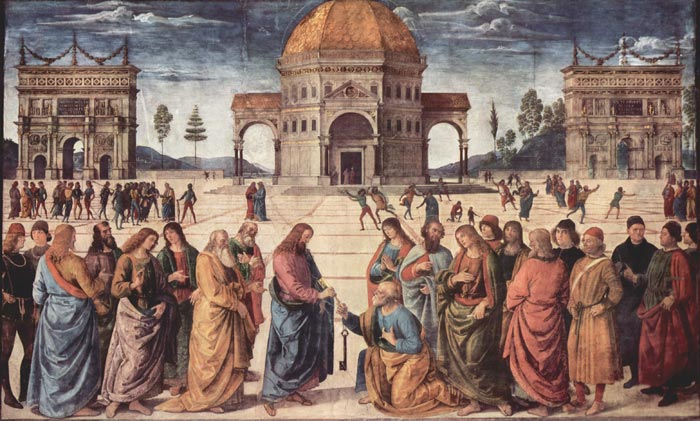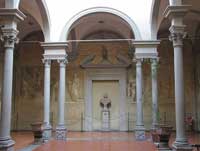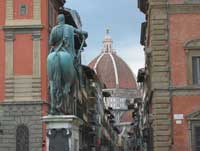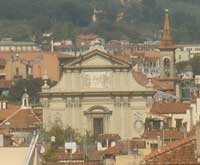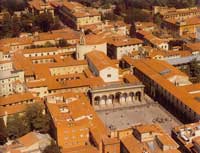How great a benefit poverty may be to men of genius, and how potent a force it may be to make them become excellent nay, perfect in the exercise of any faculty whatsoever, can be seen clearly enough in the actions of Pietro Perugino, who, flying from the extremity of distress at Perugia, and betaking himself to Florence in the desire to attain to some distinction by means of his talent, remained for many months without any other bed than a miserable chest to sleep in, turning night into day, and devoting himself with the greatest ardour to the unceasing study of his profession. And, having made a habit of this, he knew no other pleasure than to labour continually at his art, and to be for ever painting ; for with the fear of poverty constantly before his eyes, he would do for gain such work as he would probably not have looked at if he had possessed the wherewithal to live. Riches, indeed, might perchance have closed the path on which his talent should advance towards excellence, no less effectually than poverty opened it to him, while necessity spurred him on in his desire to rise from so low and miserable a condition, if not to supreme eminence, at least to a rank in which he might have the means of life. For this reason he never took heed of cold, of hunger, of hardship, of discomfort, of fatigue, or of ridicule, if only he might one day live in ease and repose ; ever saying, as it were by way of proverb, that after bad weather there must come the good, and that during the good men build the houses that are to shelter them when there is need.
But in order that the rise of this craftsman may be better known, let me begin with his origin, and relate that, according to common report, there was born in the city of Perugia, to a poor man of Castello della Pieve, named Cristofano, a son who was baptized with the name of Pietro. This son, brought up amid misery and distress, was given by his father as a shop-boy to a painter of Perugia, who was no great master of his profession, but held in great veneration both the art and the men who were excellent therein; nor did he ever cease to tell Pietro how much gain and honour painting brought to those who practised it well, and he would urge the boy to the study of that art by recounting to him the rewards won by ancient and modern masters; wherefore he fired his mind in such a manner, that Pietro took it into his head to try, if only fortune would assist him, to become one of these. For this reason he was often wont to ask any man whom he knew to have seen the world, in what part the best craftsmen in that calling were formed ; particularly his master, who always gave him one and the same answer namely, that it was in Florence more than in any other place that men became perfect in all the arts, especially in painting, since in that city men are spurred by three things. The first is censure, which is uttered freely and by many, seeing that the air of that city makes men's intellects so free by nature, that they do not content themselves, like a flock of sheep, with mediocre works, but ever consider them with regard to the honor of the good and the beautiful rather than out of respect for the craftsman.
The second is that, if a man wishes to live there, he must be industrious, which is naught else than to say that he must continually exercise his intelligence and his judgment, must be ready and adroit in his affairs, and, finally, must know how to make money, seeing that the territory of Florence is not so wide or abundant as to enable her to support at little cost all who live there, as can be done in countries that are rich enough. The third, which is perchance no less potent than the others, is an eager desire for glory and honor, which is generated mightily by that air in the men of all professions; and this desire, in all persons of spirit, will not let them stay content with being equal, much less inferior, to those whom they see to be men like themselves, although they may recognize them as masters nay, it forces them very often to desire their own advancement so eagerly, that, if they are not kindly or wise by nature, they turn out evil-speakers, ungrateful, and unthankful for benefits. It is true, indeed, that when a man has learnt there as much as suffices him, he must, if he wishes to do more than live from day to day like an animal, and desires to become rich, take his departure from that place and find a sale abroad for the excellence of his works and for the repute conferred on him by that city, as the doctors do with the fame derived from their studies^ For Florence treats her craftsmen as time treats its own works, which, when perfected, it destroys and consumes little by little.
Moved by these counsels, therefore, and by the persuasions of many others, Pietro came to Florence, minded to become excellent; and well did he succeed, for the reason that in those times works in his manner were held in very great price. He studied under the discipline of Andrea Verrocchio, and his first figures were painted without the Porta a Prato, in the Nunnery of S. Martino, now in ruins by reason of the wars. In Camaldoli he made a S. Jerome on a wall, which was then much esteemed by the Florentines and celebrated with great praise, for the reason that he made that Saint old, lean, and emaciated, with his eyes fixed on the Crucifix, and so wasted away, that he seems like an anatomical model, as may be seen from a copy of that picture which is in the hands of the aforesaid Bartolommeo Gondi. In a few years, then, he came into such credit, that his works filled not only Florence and all Italy, but also France, Spain, and many other countries to which they were sent. Wherefore, his paintings being held in very great price and repute, merchants began to buy them up wholesale and to send them abroad to various countries, to their own great gain and profit.
For the Nuns of S. Chiara he painted a Dead Christ on a panel, with such lovely and novel coloring, that he made the craftsmen believe that he would become excellent and marvellous. In this work there are seen some most beautiful heads of old men, and likewise certain figures of the Maries, who, having ceased to weep, are contemplating the Dead Jesus with extraordinary awe and love; not to mention that he made therein a landscape that was then held most beautiful, because the true method of making them, such as it appeared later, had not yet been seen. It is said that Francesco del Pugliese offered to give to the aforesaid nuns three times as much money as they had paid to Pietro, and to have a similar one made for them by the same man's hand, but that they would not consent, because Pietro said that he did not believe he could equal it. There were also many things by the hand of Pietro in the Convent of the Frati Gesuati, without the Porta a Pinti; and since the said church and convent are now in ruins, I do not wish, with this occasion, and before I proceed further with this Life, to grudge the labour of giving some little account of them. This church, then, the architect of which was Antonio di Giorgio of Settignano, was forty braccia long and twenty wide. At the upper end one ascended by four treads, or rather steps, to a platform six braccia in extent, on which stood the high altar, with many ornaments carved in stone; and on the said altar was a panel with a rich ornament, by the hand, as has been related, of Domenico Ghirlandajo.
In the center of the church was a partition wall, with a door wrought in open-work from the middle upwards, on either side of which was an altar, while over either altar, as will be told, there stood a panel by the hand of Pietro Perugino. Over the said door was a most beautiful Crucifix by the hand of Benedetto da Maiano, with a Madonna on one side and a S. John on the other, both in relief. Before the said platform of the high altar, and against the said partition wall, was a choir of the Doric Order, very well wrought in walnut wood; and over the principal door of the church there was another choir, which rested on well-strengthened woodwork, with the under part forming a ceiling, or rather soffit, beautifully partitioned, and with a row of balusters acting as parapet to the front of the choir, which faced towards the high altar. This choir was very convenient to the friars of that convent for holding their night services, for saying their individual prayers, and likewise for weekdays. Over the principal door of the church which was made with most beautiful ornaments of stone, and had a portico in front raised on columns, which made a covered way as far as the door of the convent was a lunette with a very beautiful figure of S. Giusto, the Bishop, and an angel on either side, by the hand of the illuminator Gherardo; and this because that church was dedicated to the said S. Giusto, and within it those friars preserved a relic of that Saint that is, an arm.
At the entrance of the convent was a little cloister of exactly the same size as the church namely, forty braccia long and twenty wide with arches and vaulting going right round and supported by columns of stone, thus making a spacious and most commodious loggia on every side. In the center of the court of this cloister, which was all neatly paved with squared stone, was a very beautiful well, with a loggia above, which likewise rested on columns of stone, and made a rich and beautiful ornament. In this cloister were the chapterhouse of the friars, the side door of entrance into the church, and the stairs that ascended to the dormitory and other rooms for the use of the friars. On the farther side of this cloister, in a straight line with the principal door of the convent, was a passage as long as the chapterhouse and the steward's room put together, leading into another cloister larger and more beautiful than the first; and the whole of this straight line that is, the forty braccia of the loggia of the first cloister, the passage, and the line of the second cloister made a very long enfilade, more beautiful than words can tell, and the rather as from that farther cloister, in the same straight line, there issued a gardenwalk two hundred braccia in length; and all this, as one came from the principal door of the convent, made a marvellous view. In the said second cloister was a refectory, sixty braccia long and eighteen wide, with all those well-appointed rooms, and, as the friars call them, offices, which were required in such a convent. Over this was a dormitory in the shape of a T, one part of which namely, the principal part in the direct line, which was sixty braccia long was double that is to say, it had cells on either side, and at the upper end, in a space of fifteen braccia, was an oratory, over the altar of which there was a panel by the hand of Pietro Perugino; and over the door of this oratory was another work by the same man's hand, in fresco, as will be told. And on the same floor, above the chapterhouse, was a large room where those fathers worked at making glass windows, with the little furnaces and other conveniences that were necessary for such an industry; and since while Pietro lived he made the cartoons for many of their works, those that they executed in his time were all excellent. Then the garden of this convent was so beautiful and so well kept, and the vines were trained round the cloister and in every place with such good order, that nothing better could be seen in the neighborhood of Florence. In like manner the room wherein they distilled scented waters and medicines, as was their custom, had all the best conveniences that could possibly be imagined. In short, that convent was one of the most beautiful and best appointed that there were in the State of Florence; and it is for this reason that I have wished to make this record of it, and the rather as the greater part of the pictures that were therein were by the hand of our Pietro Perugino.
Returning at length to this Pietro, I have to say that of the works that he made in the said convent none have been preserved save the panels, since those executed in fresco were thrown to the ground, together with the whole of that building, by reason of the siege of Florence, when the panels were carried to the Porta a S. Pier Gattolini, where a home was given to those friars in the Church and Convent of S. Giovannino. Now the two panels on the aforesaid partition-wall were by the hand of Pietro; and in one was Christ in the Garden, with the Apostles sleeping, in whom Pietro showed how well sleep can prevail over pains and discomforts, having represented them asleep in attitudes of perfect ease. In the other he made a Pieta' that is, Christ in the lap of Our Lady surrounded by four figures no less excellent than any others in his manner; and, to mention only one thing, he made the Dead Christ all stiffened, as if He had been so long on the Cross that the length of time and the cold had reduced Him to this; wherefore he painted Him supported by John and the Magdalene, all sorrowful and weeping. In another panel he painted the Crucifixion, with the Magdalene, and, at the foot of the Cross, S. Jerome, S. John the Baptist, and the Blessed Giovanni Colombini, founder of that Order; all with infinite diligence .These three panels have suffered considerably, and they are all cracked in the dark parts and where there are shadows; and this comes to pass when the first coat of color, which is laid on the ground (for three coats of colour are used, one over the other) , is worked on before it is thoroughly dry; wherefore afterwards, with time, in the drying, they draw through their thickness and come to have the strength to make those cracks; which Pietro could not know, seeing that in his time they were only just beginning to paint well in oil.
Now, the works of Pietro being much commended by the Florentines, a Prior of the same Convent of the Ingesuati, who took delight in art, caused him to make a Nativity, with the Magi, on a wall in the first cloister, after the manner of a miniature. This he brought to perfect completion with great loveliness and a high finish, and it contained an infinite number of different heads, many of them portrayed from life, among which was the head of Andrea del Verrocchio, his master. In the same court, over the arches of the columns, he made a frieze with heads of the size of life, very well executed, among which was one of the said Prior, so lifelike and wrought in so good a manner, that it was judged by the most experienced craftsmen to be the best thing that Pietro ever made. In the other cloister, over the door that led into the refectory, he was commissioned to paint a scene of Pope Boniface confirming the habit of his Order to the Blessed Giovanni Colombino, wherein he portrayed eight of the aforesaid friars, and made a most beautiful view receding in perspective, which was much extolled, and lightly, since Pietro made a particular profession of this. In another scene below the first he began a Nativity of Christ, with certain angels and shepherds, wrought with the freshest coloring. And in an arch over the door of the aforesaid oratory he made three half-length figures Our Lady, S. Jerome, and the Blessed Giovanni with so beautiful a manner, that this was held to be one of the best mural paintings that Pietro ever wrought.
The said Prior, so I once heard tell, was very excellent at making ultramarine blues, and, therefore, having an abundance of them, he desired that Pietro should use them freely in all the above-mentioned works; but he was nevertheless so mean and suspicious that he would never trust Pietro, and always insisted on being present when he was using blue in the work. Wherefore Pietro, who had an honest and upright nature, and had no desire for another man's goods save in return for his own labor, took the Prior's distrust very ill, and resolved to put him to shame; and so, having taken a basin of water, and having laid on the ground for draperies or for anything else that he wished to paint in blue and white, from time to time he caused the Prior, who turned grudgingly to his little bag, to put some ultramarine into the little vase that contained the tempera-water, and then, setting to work, at every second stroke of the brush Pietro would dip his brush in the basin, so that there remained more in the water than he had used on the picture. The Prior, who saw his little bag becoming empty without much to show for it in the work, kept saying time after time: "Oh, what a quantity of ultramarine this plaster consumes!" " Does it not?" Pietro would answer. After the departure of the Prior, Pietro took the ultramarine from the bottom of the basin, and gave it back to him when he thought the time had come, saying: "Father, this is yours; learn to trust honest men, who never cheat those who trust them, although, if they wished, they could cheat such distrustful persons as yourself."
By reason of these works, then, and many others, Pietro came into such repute that he was almost forced to go to Siena, where he painted a large panel, which was held very beautiful, in S. Francesco; and he painted another in S. Agostino, containing a Crucifix with some saints. A little time after this, for the Church of S. Gallo in Florence, he painted a panel picture of S. Jerome in Penitence, which is now in S. Jacopo tra Fossi, where the aforesaid friars live, near the Canto degli Alberti. He was commissioned to paint a Dead Christ, with the Madonna and S. John, above the steps of the side-door of S. Pietro Maggiore ; and this he wrought in such a manner, that it has been preserved, although exposed to rain and wind, as fresh as if it had only just been finished by Pietro's hand. Truly intelligent was Pietro's understanding of color, both in fresco and in oil; wherefore all experienced craftsmen are indebted to him, for it is through him that they have knowledge of the lights that are seen throughout his works.
In S. Croce, in the same city, he made a Pieta that is, Our Lady with the Dead Christ in her arms and two figures, which are marvellous to behold, not so much for their excellence, as for the fact that they have remained so fresh and vivid in coloring, painted as they are in fresco. He was commissioned by Bernardino de' Rossi, a citizen of Florence, to paint a S. Sebastian to be sent into France, the price agreed on being one hundred gold crowns ; but this work was sold by Bernardino to the King of France for four hundred gold ducats. At Vallombrosa he painted a panel for the high altar; and in the Certosa of Pavia, likewise, he executed a panel for the friars of that place. At the command of Cardinal Caraffa of Naples he painted an Assumption of Our Lady, with the Apostles marvelling round the tomb, for the high altar of the Piscopio; and for Abbot Simone de' Graziani of Borgo a San Sepolcro he executed a large panel, which was painted in Florence, and then borne to S. Gilio in the Borgo on the shoulders of porters, at very great expense. To S. Giovanni in Monte at Bologna he sent a panel with certain figures standing upright, and a Madonna in the sky.
Thereupon the fame of Pietro spread so widely throughout Italy and abroad, that to his great glory he was summoned to Rome by Pope Sixtus IV to work in his chapel in company with the other excellent craftsmen. There, in company with Don Bartolommeo della Gatta, Abbot of S. Clemente at Arezzo, he painted the scene of Christ giving the keys to S. Peter; and likewise the Nativity and Baptism of Christ, and the Birth of Moses, with the daughter of Pharaoh finding him in the little ark. And on the same wall where the altar is he painted a mural picture of the Assumption of Our Lady, with a portrait of Pope Sixtus on his knees. But these works were thrown to the ground in preparing the wall for the Judgment of the divine Michel agnolo, in the time of Pope Paul III. On a vault of the Borgia Tower in the Papal Palace he painted certain stories of Christ, with some foliage in chiaroscuro, which had an extraordinary name for excellence in his time. In S. Marco, likewise in Rome, he painted a story of two martyrs beside the Sacrament one of the best works that he made in Rome. For Sciarra Colonna, also, in the Palace of S. Apostolo, he painted a loggia and certain rooms.
These works brought him a very great sum of money; wherefore, having resolved to remain no longer in Rome, and having departed in good favor with the whole Court, he returned to his native city of Perugia, in many parts of which he executed panels and works in fresco; and, in particular, a panel-picture painted in oils for the Chapel of the Palace of the Signori, containing Our Lady and other saints. In S. Francesco del Monte he painted two chapels in fresco, one with the story of the Magi going to make offering to Christ, and the other with the martyrdom of certain friars of S. Francis, who, going to the Soldan of Babylon, were put to death. In S. Francesco del Convento, likewise, he painted two panels in oil, one with the Resurrection of Christ, and the other with S. John the Baptist and other saints. For the Church of the Servi he also painted two panels, one of the Transfiguration of Our Lord, and in the other, which is beside the sacristy, the Story of the Magi; but, since these are not of the same excellence as the other works of Pietro, it is held to be certain that they are among the first that he made. In the Chapel of the Crocifisso in S. Lorenzo, the Duomo of the same city, there are by the hand of Pietro the Madonna, the other Maries, S. John, S. Laurence, S. James, and other saints. And for the Altar of the Sacrament, where there is preserved the ring with which the Virgin Mary was married, he painted the Marriage of the Virgin.
Afterwards he painted in fresco the whole of the Audience Chamber of the Cambio, adorning the compartments of the vaulting with the seven planets, drawn in certain cars by diverse animals, according to the old usage; on the wall opposite to the door of entrance he painted the Nativity and Resurrection of Christ, with a panel containing S. John the Baptist in the midst of certain other saints. The side-walls he painted in his own manner; one with figures of Fabius Maximus, Socrates, Numa Pompilius, F. Camillus, Pythagoras, Trajan, L. Sicinius, the Spartan Leonidas, E ratius Codes, Fabius, Sempronius, the Athenian Pericles, and Cincinnatus. On the other wall he made the Prophets, Isaiah, Moses, Daniel, David, Jeremiah, and Solomon ; and the Sibyls, the Erythraean, the Libyan, the Tiburtine, the Delphic, and the others. Below each of the said figures he placed, in the form of a written motto, something said by them, and appropriate to that place. And in one of the ornaments he made his own portrait, which appears absolutely alive, and he wrote his own name below it in the following manner:
PETRUS PERUSINUS EGREGIUS PICTOR.
PERDITA SI FUERAT, PINGENDO HIC RETULIT ARTEM
SI NUNQUAM INVENTA ESSEX HACTENUS, IPSE DEBIT.
ANNO D. 1500.
This work, which was very beautiful and more highly extolled than any other that was executed by Pietro in Perugia, is now held in great price by the men of that city in memory of so famous a craftsman of their own country. Afterwards, in the principal chapel of the Church of S. Agostino, the same man executed a large panel standing by itself and surrounded by a rich ornament, with S. John baptizing Christ on the front part, and on the back that is, on the side that faces the choir the Nativity of Christ, with certain saints in the upper parts, and in the predella many scenes wrought very diligently with little figures. And in the Chapel of S. Niccolo, in the said church, he painted a panel for Messer Benedetto Calera.
After this, returning to Florence, he painted a S. Bernard on a panel for the Monks of Cestello, and in the chapterhouse a Crucifix, the Madonna, S. Benedict, S. Bernard, and S. John. And in S. Domenico da Fiesole, in the second chapel on the right hand, he painted a panel containing Our Lady and three figures, among which is a S. Sebastian worthy of the highest praise. Now Pietro had done so much work, and he always had so many works in hand, that he would very often use the same subjects ; and he had reduced the theory of his art to a manner so fixed, that he made all his figures with the same expression. By that time Michelagnolo Buonarroti had already come to the front, and Pietro greatly desired to see his figures, by reason of the praise bestowed on him by craftsmen; and seeing the greatness of his own name, which he had acquired in every place through so grand a beginning, being obscured, he was ever seeking to wound his fellow workers with biting words. For this reason, besides certain insults aimed at him by the craftsmen, he had only himself to blame when Michelagnolo told him in public that he was a clumsy fool at his ait[SIC]. But Pietro being unable to swallow such an affront, they both appeared before the Tribunal of Eight, where Pietro came off with little honor.
Meanwhile the Servite Friars of Florence, wishing to have the altarpiece of their high altar painted by some famous master, had handed it over, by reason of the departure of Leonardo da Vinci, who had gone off to France, to Filippino; but he, when he had finished half of one of two panels that were to adorn the altar, passed from this life to the next; wherefore the friars, by reason of the faith that they had in Pietro, entrusted him with the whole work. In that panel, wherein he was painting the Deposition of Christ from the Cross, Filippino had finished the figures of Nicodemus that are taking Him down; and Pietro continued the lower part with the Swooning of the Madonna, and certain other figures. Now this work was to be composed of two panels, one facing towards the choir of the friars, and the other towards the body of the church, and the Deposition from the Cross was to be placed behind, facing the choir, with the Assumption of Our Lady in front; but Pietro made the latter so commonplace, that the Deposition of Christ was placed in front, and the Assumption on the side of the choir. These panels have now been removed, both one and the other, and replaced by the Tabernacle of the Sacrament; they have been set up over certain other altars in that church, and out of the whole work there only remain six pictures, wherein are some saints painted by Pietro in certain niches. It is said that when the work was unveiled, it received no little censure from all the new craftsmen, particularly because Pietro had availed himself of those figures that he had been wont to use in other pictures; with which his friends twitted him, saying that he had taken no pains, and that he had abandoned the good method of working, either through avarice or to save time. To this Pietro would answer: "I have used the figures that you have at other times praised, and which have given you infinite pleasure; if now they do not please you, and you do not praise them, what can I do?" But they kept assailing him bitterly with sonnets and open insults; whereupon, although now old, he departed from Florence and returned to Perugia.
There he executed certain works in fresco in the Church of S. Severo, a place belonging to the Monks of the Order of Camaldoli, wherein Raffaello da Urbino, when quite young and still the disciple of Pietro, had painted certain figures, as will be told in his Life. Pietro likewise worked at Montone, at La Fratta, and in many other places in the district of Perugia; more particularly in S. Maria degli Angeli at Assisi, where he painted in fresco a Christ on the Cross, with many figures, on the wall at the back of the Chapel of the Madonna, which faces the choir of the monks. And for the high altar of the Church of S. Pietro, an abbey of Black Friars in Perugia, he painted a large panel containing the Ascension, with the Apostles below gazing up to Heaven; in the predella of which panel are three stories, wrought with much diligence namely, that of the Magi, the Baptism of Christ, and His Resurrection. The whole of this picture is seen to be full of beautiful and careful work, insomuch that it is the best of those wrought in oil by the hand of Pietro which are in Perugia. The same man began a work in fresco of no small importance at Castello della Pieve, but did not finish it.
It was ever Pietro's custom on his going and coming between the said Castello and Perugia, like a man who trusted nobody, to carry all the money that he possessed about his person. Wherefore certain men, lying in wait for him at a pass, robbed him, but at his earnest entreaty they spared his life for the love of God; and afterwards, by means of the services of his friends, who were numerous enough, he also recovered a great part of the money that had been taken from him; but none the less he came near dying of vexation. Pietro was a man of very little religion, and he could never be made to believe in the immortality of the soul nay, with words in keeping with his head of granite, he rejected most obstinately every good suggestion. He placed all his hopes in the goods of fortune, and he would have sold his soul for money. He earned great riches; and he both bought and built houses in Florence, and acquired much settled property both at Perugia and at Castello della Pieve. He took a most beautiful young woman to wife, and had children by her; and he delighted so greatly in seeing her wearing beautiful headdresses, both abroad and at home, that it is said that he would often tire her head with his own hand. Finally, having reached the! age of seventy-eight, Pietro finished the course of his life at Castello della Pieve, where he was honorably buried, in the year 1524.
Pietro made many masters in his own manner, and one among them, who was truly most excellent, devoted himself heart and soul to the honorable studies of painting, and surpassed his master by a great measure; and this was the miraculous Raffaello Sanzio of Urbino, who worked for many years under Pietro in company with his father, Giovanni de' Santi. Another disciple of this man was Pinturicchio, a painter of Perugia, who, as it has been said in his Life, ever held to Pietro's manner. His disciple, likewise, was Rocco Zoppo, a painter of Florence, by whose hand is a very beautiful Madonna in a round picture, which is in the possession of Filippo Salviati; although it is true that it was brought to completion by Pietro himself. The same Rocco painted many pictures of Our Lady, and made many portraits, of which there is no need to speak I will only say that in the Sistine Chapel in Rome he painted portraits of Girolamo Riario and of F. Pietro, Cardinal of San Sisto. Another disciple of Pietro was Montevarchi, who painted many pictures in San Giovanni di Valdarno ; more particularly, in the Madonna, the stories of the Miracle of the Milk. He also left many works in Montevarchi, his birth-place. Likewise a pupil of Pietro's, working with him for no little time, was Gerino da Pistoia, of whom there has been mention in the Life of Pintu- ricchio ; and so also was Baccio Ubertino of Florence, who was most diligent both in colouring and in drawing, for which reason Pietro made much use of him. By this man's hand is a drawing in our book, done with the pen, of Christ being scourged at the Column, which is a very lovely thing.
A brother of this Baccio, and likewise a disciple of Pietro, was Fran- cesco, called II Bacchiaccha by way of surname, who was a most diligent master of little figures, as may be seen in many works wrought by him in Florence, above all in the house of Giovan Maria Benintendi and in that of Pier Francesco Borgherini. Bacchiaccha delighted in painting grotesques, wherefore he covered a little cabinet belonging to the Lord Duke Cosimo with animals and rare plants, drawn from nature, which are held very beautiful. Besides this, he made the cartoons for many tapestries, which were afterwards woven in silk by the Flemish master, Giovanni Rosto, for the apartments of his Excellency's Palace. Still another disciple of Pietro was the Spaniard Giovanni, called Lo Spagna by way of surname, who was a better colorist than any of the others whom Pietro left behind him at his death; after which this Giovanni would have settled in Perugia, if the envy of the painters of that city, so hostile to strangers, had not persecuted him in such wise as to force him to retire to Spoleto, where, by reason of his excellence and virtue, he obtained a wife of good family and was made a citizen of that city. He made many works in that place, and likewise in all the other cities of Umbria ; and at Assisi, in the lower Church of S. Francesco, he painted the panel of the Chapel of S. Caterina, for the Spanish Cardinal Egidio, and also one in S. Damiano. In S. Maria degli Angeli, in the little chapel where S. Francis died, he painted some half-length figures of the size of life that is, certain companions of S. Francis and other saints all very lifelike, on either side of a S. Francis in relief.
But the best master among all the aforesaid disciples of Pietro was Andrea Luigi of Assisi, called L' Ingegno, who in his early youth com- peted with Raffaello da Urbino under the discipline of Pietro, who always employed him in the most important pictures that he made; as may be seen in the Audience Chamber of the Cambio in Perugia, where there are some very beautiful figures by his hand; in those that he wrought at Assisi; and, finally, in the Chapel of Pope Sixtus at Rome. In all these works Andrea gave such proof of his worth, that he was expected to surpass his master by a great measure, and so, without a doubt, it would have come to pass ; but fortune, which is almost always pleased to oppose herself to lofty beginnings, did not allow L' Ingegno to reach perfection, for a flux of catarrh fell upon his eyes, whence the poor fellow became wholly blind, to the infinite grief of all who knew him. Hearing of this most pitiful misfortune, Pope Sixtus, like a man who ever loved men of talent, ordained that a yearly provision should be paid to Andrea in Assisi during his lifetime by those who managed the revenues there; and this was done until he died at the age of eighty-six.
Likewise disciples of Pietro, and also natives of Perugia, were Eusebio San Giorgio, who painted the panel of the Magi in S. Agostino; Domenico di Paris, who made many works in Perugia and in the neighbouring townships, being followed by his brother Orazio; and also Gian Niccola, who painted Christ in the Garden on a panel in S. Francesco, the panel of Ognissanti in the Chapel of the Baglioni in S. Domenico, and stories of S. John the Baptist in fresco in the Chapel of the Cambio. Benedetto Caporali, otherwise called Bitti, was also a disciple of Pietro, and there are many pictures by his hand in his native city of Perugia. And he occupied himself so greatly with architecture, that he not only executed many works, but also wrote a commentary on Vitruvius in the manner that all can see, for it is printed; in which studies he was followed by his son Giulio, a painter of Perugia.
But not one out of all these disciples ever equalled Pietro's diligence, or the grace of coloring that he showed in that manner of his own, which pleased his time so much, that many came from France, from Spain, from Germany, and from other lands, to learn it. And a trade was done in his works, as has been said, by many who sent them to diverse places, until there came the manner of Michelagnolo, which, having shown the true and good path to these arts, has brought them to that perfection which will be seen in the Third Part, about to follow, wherein we will treat of the excellence and perfection of art, and show to craftsmen that he who labors and studies continuously, and not in the way of fantasy or caprice, leaves true works behind him and acquires fame, wealth, and friends. |
|
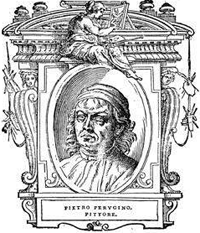
Pietro Perugino
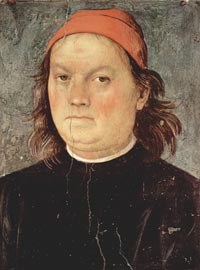 Pietro Perugino, Self-portrait, 1497–1500, Pietro Perugino, Self-portrait, 1497–1500,
Collegio del Cambio, Perugia.
|
